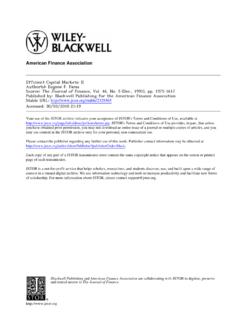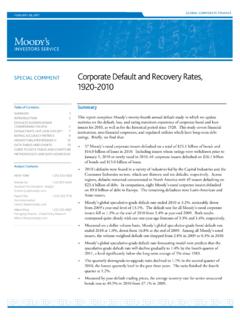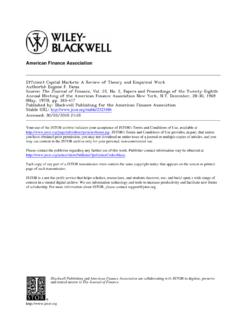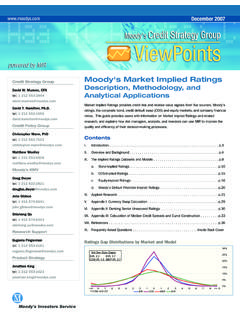Transcription of The Equity Premium: Stock and Bond Returns since 1802
1 CFA InstituteThe Equity premium : Stock and bond Returns since 1802 Author(s): Jeremy J. SiegelSource: Financial Analysts Journal, Vol. 48, No. 1 (Jan. - Feb., 1992), pp. 28-38+46 Published by: CFA InstituteStable URL: : 30/03/2010 21:52 Your use of the JSTOR archive indicates your acceptance of JSTOR's Terms and Conditions of Use, available JSTOR's Terms and Conditions of Use provides, in part, that unlessyou have obtained prior permission, you may not download an entire issue of a journal or multiple copies of articles, and youmay use content in the JSTOR archive only for your personal, non-commercial contact the publisher regarding any further use of this work. Publisher contact information may be obtained copy of any part of a JSTOR transmission must contain the same copyright notice that appears on the screen or printedpage of such is a not-for-profit service that helps scholars, researchers, and students discover, use, and build upon a wide range ofcontent in a trusted digital archive.
2 We use information technology and tools to increase productivity and facilitate new formsof scholarship. For more information about JSTOR, please contact Institute is collaborating with JSTOR to digitize, preserve and extend access to Financial en C, :D LLU LL~ :D z z :D 0 LI, -J z u z z L2 28 Jeremy J. Siegel Over the period from 1802 through 1990, Equity has provided Returns superior to those on fixed income investments, gold or com- modities. Most strikingly, the real rate of return on Equity held remarkably constant over this period, while the real return on fixed income assets de- clined dramatically. Over the subperiods 1802-70, 1871-1925 and 1926-90, the real compound annual Returns on Equity were 5. 7, and per cent, but the real Returns on short- term government bonds dropped from to and, finally, per cent.
3 The magnitude of the ex- cess return on Equity , espe- cially during this century, appears excessive relative to the behavior of other mac- roeconomic variables. In the future, the real return on fixed income assets may be closer to the historical norm of 3 to 4 per cent. While Stock Returns will probably continue to domi- nate bond Returns , they will not do so by nearly as wide a margin as they have over the past 65 years. since 1926, the compound real value-weighted return on all stocks listed on the New York The Equity premium : Stock and bond Returns since 1802 Stock Exchange has averaged per cent per year, while the real return on Treasury bills has aver- aged only per This means that the purchasing power of a given sum of money invested (and reinvested) in stocks from 1926 to 1990 would have in- creased over 50 times, while re- investment in bills would have increased one's real wealth by about one-third.
4 Using these his- torical Returns , it would take 139 years of investing in Treasury bills to double one's real wealth while it would take only 11 years of Stock investment. Money manag- ers often use these figures per- suasively to convince investors that, over long periods of time, Equity has no match as a wealth builder. The return on stocks in excess of the return on short-term bonds is called the Equity premium . Be- cause stocks are generally riskier than fixed income investments, it is to be expected that the return on stocks would exceed that on bonds. However, in 1985 Rajnish Mehra and Edward Prescott dem- onstrated that stocks , despite their risk, appear to offer inves- tors excessive Returns , while bonds offer puzzlingly low re- The excessive return on Equity is termed the " Equity pre- mium puzzle." Investors would have to be extraordinarily risk- averse, given the documented growth and variability of the economy, to accept such low re- turns on bonds while Equity of- fered such superior Returns .
5 Such extreme risk-aversion appears to be inconsistent with data that re- veal investor choice under uncer- tainty. Many theories have been offered to explain the Equity premium The data that Mehra and Prescott analyzed covered a suffi- ciently long period of time and were derived from well docu- mented sources. Thus no one questioned the validity of their return data. I extended the time period ana- lyzed by Mehra and Prescott back to 1802, while updating the re- turns on stocks and bonds to 1990. My analysis demonstrates that the Returns from bonds dur- ing most of the 19th century and after 1980 were far higher than in the period analyzed by Mehra and Prescott. The Equity premium is not nearly as large when viewed over this extended time span as it is in the post-1926 period. These data suggest that the excess re- turn of stocks over bonds may be significantly smaller in the future than it has been over the past 65 years.
6 Long-Term Asset Returns William Schwert has developed historical Stock price series dating back to 1802; there are also some fragmentary data on Stock Returns dating to In order to ana- lyze asset Returns since 1802, 1 divided the data into three subpe- riods. The first period, running from 1802 through 1870, contains stocks of financial firms and, later, railroads. The second period, running from 1871 through 1925, comprises the period studied by the Cowles The last subperiod, from 1926 to the present, coincides with the devel- opment of the S&P 500 Stock in- dex and contains the most com- prehensive data on Stock prices and other economic I use the Schwert data for the first subperiod and a capitalization- weighted index of all NYSE stocks Glossary * Equity premium : The expected return (divi- dends plus capital gains) on Equity in excess of the return on safe assets such as govern- ment bonds.
7 *' Total return Index: An index that measures the increase in wealth generated by assuming that all cash flows and capital gains are reinvested in the same asset or class of assets. * Capital Appreciation Index: An index that measures the increase in wealth assuming that just the capital gain, and not any income generated, is reinvested in the asset (or class of assets). *Geometric return : Compound return , or the nth root of the n single-year re- turns. *Synthetic Short-Term Government Series: A series of what short-term, risk-free interest rates would be, based on removing the default premium on similar risky assets. Computed in the absence of actual government interest rates. for the second and third subperi- ods. The early Stock indexes were not as comprehensive as those con- structed today. From 1802 to 1820, the Stock index consisted of an equally weighted portfolio of stocks of several banks in Boston, New York and Philadelphia.
8 An insurance company was added later, and in 1834 the portfolio became heavily weighted toward railroad stocks . The Cowles index consisted of all stocks listed on the New York Stock Exchange and recorded, for the first time, dividend payments. The Cowles index is spliced to modern in- dexes, which calculate averages for all classes of common Stock . Stock Returns Figure A displays what one dollar invested in various asset classes in 1802 would have accumulated to by the end of 1990. These series are referred to as total return indexes, because they assume that all cash flows, including in- terest and dividends as well as any capital gains, are continually reinvested in the relevant asset. Total return indexes differ from standard Stock market indexes such as the S&P 500, which do not include the reinvestment of cash flows. These standard indexes are called capital appreciation in- dexes.
9 ' Figure A indicates that, in terms of total return , stocks have domi- nated all other asset classes since 1802. Over the entire period, eq- uities achieved a compound an- nual nominal rate of return of per cent per year; at this rate, the nominal value of Equity approxi- mately doubles every years. Figure A also demonstrates that nominal Stock Returns have also increased over time. The average compound rate of return on stocks was per cent from 1802 through 1870, per cent from 1871 through 1925 and per cent from 1926 through Table I gives the Stock Returns in each subperiod. The average nominal arithmetic (or mean) return on stocks is per cent per year over the entire period. Although this can be in- terpreted as the expected return on stocks over a 12-month pe- riod, it cannot be converted into a compound annual rate of return over periods longer than one year.
10 Because of the mathematical properties of return calculations, the compound rate of return to a buy-and-hold strategy is mea- sured by the geometric, rather than the arithmetic, The power of compound Returns is clearly evident in the Stock market. One dollar invested in 1802, with all dividends rein- vested, would have accumulated to nearly $1 million by the end of 1990. Hypothetically, this means that $3 million, invested and rein- vested over these past 188 years, would have grown to the incred- ible sum of $3 trillion-nearly equal to the entire capitalization of the Stock market in 1990! Figure A Total Nominal return Indexes, Before Taxes, 1802 - 1990 10,000,000- - stocks $5,0 1,000,000 Short-Term Governments $955,000 Governments -Gold 100,000 --CP 10,000 5,770 -2,680 2 1,000 - .. 4-J 100- o E 10- Sub Period I Sub Period lI Sub Period III I IIII I 111 II11- - I I I I I I I 1800 10 20 30 40 50 60 70 80 90 1900 10 20 30 40 50 60 70 80 90 Year r4 D z m LLJ LL- w D z z cc: D 0 H- <1.










